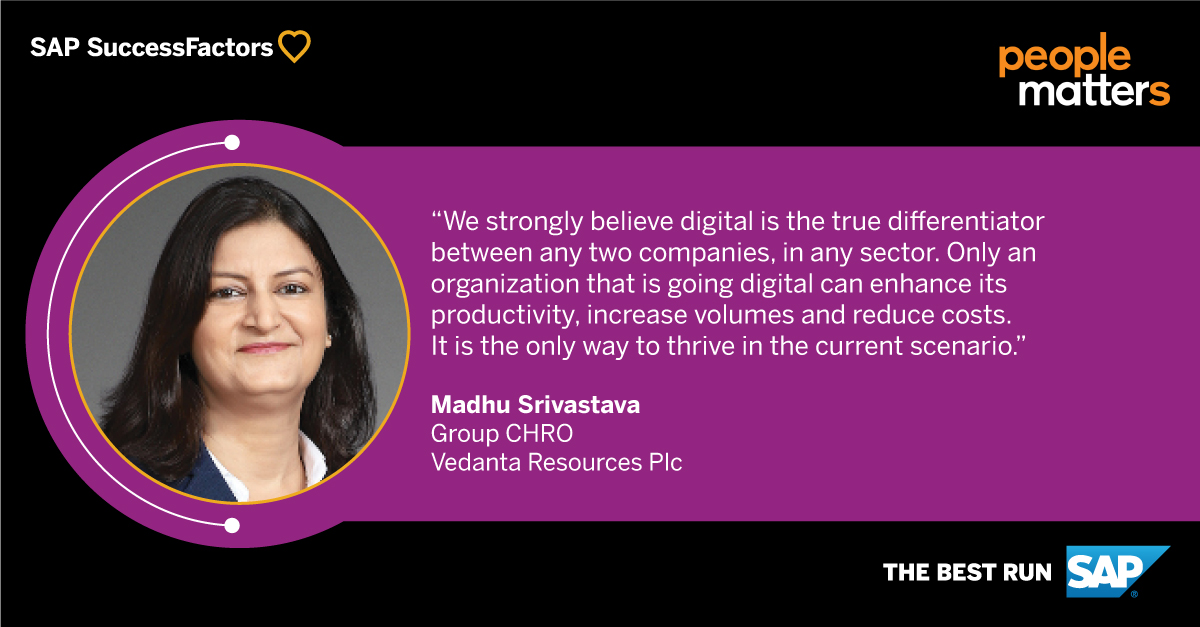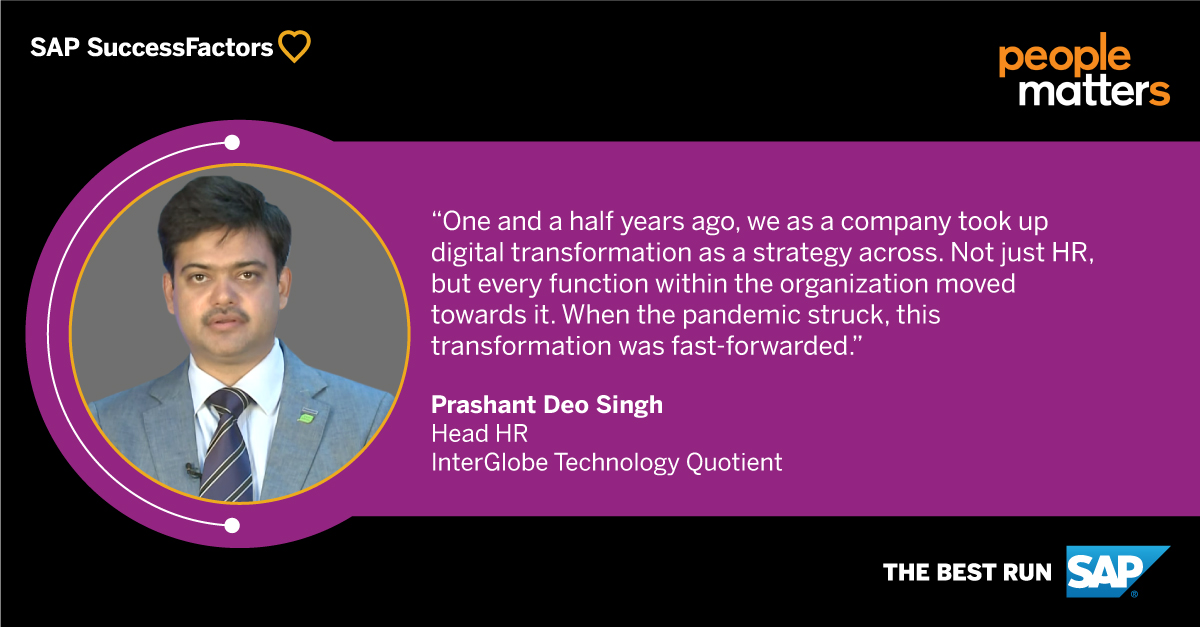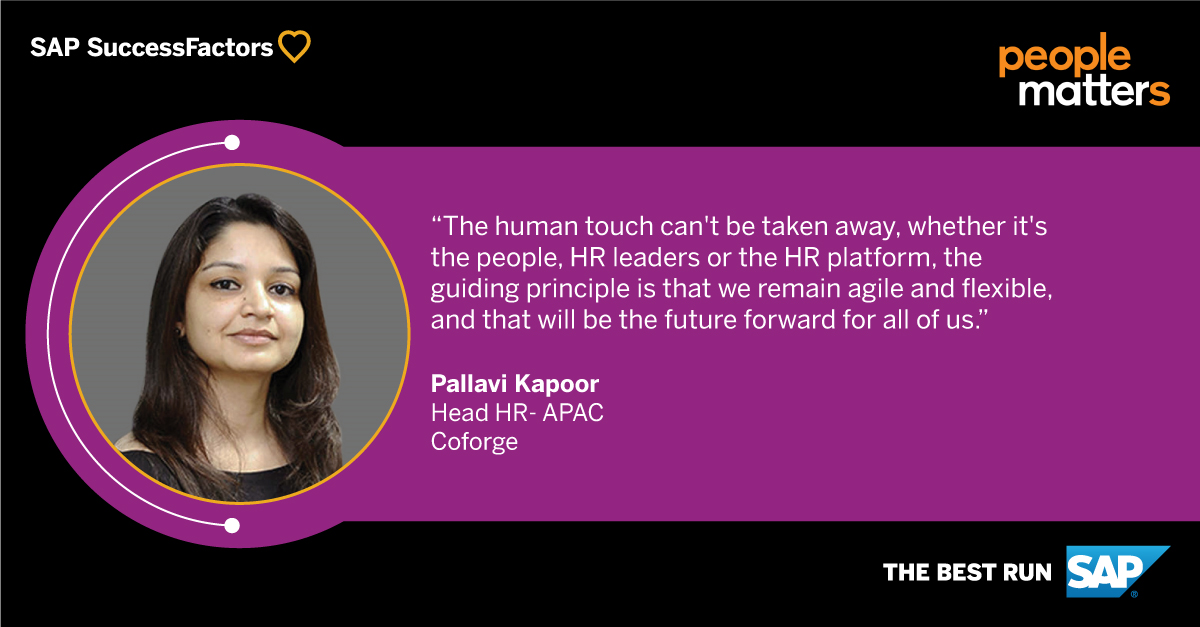2020 ushered us into a new way of working. Organizations are now moving to investing and setting up infrastructures to provide a superior work experience to their people– Hybrid 2.0. SAP organized the SAP HR Connect 2021 to throw some much-needed light on how we can design employee experiences for the hybrid 2.0 world that are holistic, progressive, agile, technology-driven, and most importantly, more human!
A fireside chat brought together a panel of talent leaders, moderated by Pallavi Kapoor, Head HR- APAC, Coforge; and including Madhu Srivastava, Group CHRO, Vedanta Resources Plc, and Prashant Deo Singh, Head HR, InterGlobe Technology Quotient.
Acknowledging the pandemic’s impact on digital transformation, the panel shed light on how companies have been forced to rethink their operating models and accelerate investments in cloud technologies, AI, and automation. And reflected upon how CHROs can become the ultimate partners to accelerate digital transformation for a better EX and continuous organizational growth.
Moving Forward: HR Technology in 2021
Kicking off the discussion, Pallavi Kapoor discussed the pandemic’s massive impact on the adoption and role of HR automation across industries. And how with almost 99% of employees working from home, there has been an increased focus on the potential of HR technologies to better engage and support a virtual workforce.
“A recent ISG survey worldwide found 46% companies are now using an HR Software-x`as-a-Service (SaaS) platform. A 20% rise from what it was just two years ago. Looking to the future, the survey also found 57% of organizations expect to be using a subscription-based SaaS by 2023.”, she said.

She added, “Digital transformation is the clear mandate for organizations. It has accelerated the kind of growth that was envisaged as a 5-year journey and compressed it into a 3-month time frame.”
Making HR Agile: The Digital Transformation Journey
Detailing the digital transformation journey Vedanta Resources – one of the world’s leading diversified natural resource companies, took on during the past 2 years, Madhu Srivastava explained, “Digital transformation has been a top priority for us even before the pandemic began. But given the circumstances, we have definitely stepped on the pedal to increase the speed at which we are bringing in this transformation.”
She emphasized the rising need for digital transformation by asserting, “We strongly believe digital is the true differentiator between any two companies, in any sector. Only an organization that is going digital can enhance its productivity, increase volumes and reduce costs. It is the only way to thrive in the current scenario.”

Listing a few of the initiatives her organization took to keep up with the times, she revealed, “We started by hiring ‘Chief Digital Officers’, not only at a group but at business levels. We also formed a ‘Digital Management Committee’ for each of our businesses. These committees were assigned to continuously review the kind of transformations that can be brought into the business. Not just in terms of digital technology, but data, analytics, AI, and the whole gamut.”
“Next, we set up a “Digital Advisory Board” where we had the best of global technology experts come in and interact with our teams – to train, share knowledge and work on outcome-oriented projects with them.” She added, “We want to be known as a technology-driven company and encourage everyone, including employees, contractors, and business partners, to have tech-enabled processes.”
Speaking on how technology is being driven as the top priority on the HR front, she said, “We have already deployed technology in bits and pieces. Now, we are planning to move our end-to-end HR services online soon. Ensuring data is available for us to make decisions based on analytics.”
Touching on InterGlobe Technology’s transformation journey, Prashant Singh added, “One and a half years ago, we as a company took up digital transformation as a strategy across. Not just HR, but every function within the organization moved towards it. When the pandemic struck, this transformation was fast-forwarded.”

“Our focus has been to integrate our HR system. Previously we have had disparate vendors and modules for various systems. But we felt that integrating systems onto one single unified platform is critical for the sake of employee experience.” Elaborating on the importance of finding the right partner, he said, “Rather than jumping onto a partner and implementing ad hoc modules, it is better to spend more time researching and identifying a partner who can take care of all your business needs.”
Decoding a few key elements that can help navigate this journey successfully, Prashant summarized, “Having filters while choosing the right solution for your organization can be quite useful. During the process of getting our tech in place, we looked at viability, functionality, features, support services, and finally the cost of the solution.”
“You should also be ready as an organization before deploying the software.” He explained, “At our organization, we refreshed all our HR policies and SOPs to get the best-in-class outcomes from the solution before deploying it. It is critical in this journey to involve people from across functions and teams, and for everyone to learn and be part of the experience.”
Listing some of the challenges faced during this journey, he added, “We had a lot of legal entities which faced separate challenges. Data handling became a major concern for us there. There were also many issues relating to access rights that needed to be addressed across the organization. Finally, the pandemic itself effectively delayed our project by putting people from our team and our vendors out of action. Despite all this, our resilience and resolve helped us push forward to our ultimate goal of getting a great HR system.”
Success Partners: Changing CHRO & CEO Dynamics
Throwing light on the increasing importance of the CHRO as a partner to the CEO, Madhu explained, “As I see it, the CFO and CHRO work as two hands to the CEO. And all three roles are critical in driving the business towards the right direction.”
“As CHRO, our role is to think of ourselves as partners to the CEO. Not just for executing but also as part of the strategic decision making and enabling the CEO to make those decisions. Starting from the business plan to organizational design, the CHRO has to partner with the CEO to translate the vision for the company into a roadmap that can be executed to deliver expected outcomes.”
On the rising role technology plays in this evolution, she said, “The CEO looks up to the CHRO for advice while making critical decisions. CHROs now have the added responsibility to ensure they are enabled and equipped – in terms of data, analytics, knowledge of trends, etc.”
Adding a key perspective to the discussion, Pallavi mentioned, “Human experience is a complete experience that a person has with a brand, both digitally and physically.” She emphasized, “Most organizations and customers are undergoing digital transformation, and it is important that the entire element is viewed together, integrated across, and then taken forward to create people experiences that take them to the next level. HR must be agile and make faster decisions. And technology is taking the front seat in bringing all of it together to ensure a seamless employee experience.”
Commenting on how technology has taken center stage even in job descriptions, Prashant added, “Even when hiring for HR, we look for people who have experience in implementing HRMO solutions. Work-from-home has been institutionalized. People are moving out of office spaces, and technology is taking up a major role in integrating employees and consumers. HR is having dialogues with CEOs & CXOs on roles can be permanently moved out of the office and technologies that can enable employees and customers.”
Elaborating further on the critical role data and analytics plays in business success, he observed, “Today everyone in the c-suite is looking for visual analytics in real-time. We can’t have HR spending precious hours creating excel sheets and presentations for reviews. We would rather take them directly to a system visual analytics, where they can view realistic data directly. That’s the kind of absolute visibility into predictive analytics that c-level executives expect, and that’s what the digital platform delivers.”
Amplifying Employee Experience: What does the future hold
Talking about the future course of their transformation journey, panel members agreed that to unlock true value in this digital journey, it is important to ensure that it is adopted across functions within the organizations.
Sharing plans, Madhu mentioned, “In terms of HR, Vedanta is ready to launch its 1st phase in October this year, and by next year, we will be 100% online. What is important to us and we will continue with, is bringing in external partners- to not just help us get the system in place, but to guide us as we adopt technology for a better employee experience. We also keep the internal communication that helps us communicate the value and benefits technology brings into the lives of our people.”
“We definitely want to live in a digital world where everything is available online, so we can stop making excel sheets and PowerPoint slides. Instead, we can just walk into a meeting and log into a system where all data is available and reviews can be conducted directly on the system.”
Recounting the takeaways from the past 2 years, Prashant added, “With technology taking center-stage, boundaries have all but disappeared. One should keep in mind that while the beauty of an integrated tech platform is extremely important, instead of having a bolt-on system we should integrate APIs wherever possible.” Ending with some critical advice, he said “In this entire technology race, we should not lose the human touch.”
Pallavi summed it up perfectly when she said, ” The human touch can’t be taken away, whether it’s the people, HR leaders or the HR platform, the guiding principle is that we remain agile and flexible, and that will be the future forward for all of us.”

Check out more posts:
Evolving Employee Experience from HCM to HXM in Hybrid 2.0 – SAP India News Center
CEO’s Perspectives on the Changing People Paradigm – SAP India News Center
Meeting Business Priorities in a Hybrid World – SAP India News Center
Thriving in the Vaccine Economy Through Human Experience – SAP India News Center



